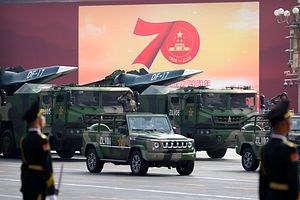Trans-Pacific View author Mercy Kuo regularly engages subject-matter experts, policy practitioners and strategic thinkers across the globe for their diverse insights into the U.S. Asia policy. This conversation with Dr. Antoine Bondaz — program director and research fellow at the Paris-based Foundation for Strategic Research (FRS) and associate professor at Sciences Po – is the 209th in “The Trans-Pacific View Insight Series.”
Assess the symbolism and substance of China’s 70th anniversary military parade.
Since Xi Jinping came to power, there has been an increase in the frequency of military parades, which are increasingly used to remind the Army’s loyalty to the Party, exalt the population’s nationalist sentiment, and introduce new military equipment. This October 1st parade is no exception and we have described it, in a recent publication, as “a revealing example of Chinese strategic power.”
As structural tensions with the United States increase and the Party faces new challenges, this parade aimed at strengthening the Party’s legitimacy by showcasing China’s prodigious economic development, its status as a major military power, while recalling Xi Jinping’s authority over the Party and the country. The new equipment presented, to which we will comment later, demonstrated the quantitative and qualitative modernization of China’s ballistic arsenal as well as the huge efforts in terms of innovation of the Chinese armed forces, which in some areas are at the forefront of global innovation. This is clearly a first and it could be probably why this parade was unique.
Explain the significance of China’s decision to showcase the Dongfeng 17 (DF-17), 41 (DF-41), and 100 (DF-100).
The Chinese ballistic forces have always had a considerable role for the Chinese armed forces, much more so than in the Western armed forces. Closely linked to Chinese nuclear deterrence, having benefited from sanctuarized development programs such as the Two Bombs One Satellite program early on and the absence of biding arm controls agreement unlike the United States, their missions have since diversified with an increasingly conventional dimension.
These ballistic forces are still today a flagship of the Chinese army, and allow, in terms of political communication, to have a considerable impact. Having paraded 36 ICBMs, a third of the ICBM’s forces according to Pentagon estimates, is a demonstration of strength both towards the United States and the Chinese population to whom the DF-41 has been presented for years as a symbol of Chinese power. This ICBM is the first Chinese solid-propelled intercontinental missile to carry a heavy payload, meaning it can carry both multiple warheads but also penetration aids, and cover the entire United States mainland.
Exhibiting the DF-17, the launcher of a hypersonic glider, also has a strong impact not so much on the nature of conventional strikes it could allow, it is not a game changer for that, but by the fact that it is the first hypersonic glider officially in service in an army, thus highlighting China’s relative advance in the field.
How does this advanced military hardware enhance China’s power projection capabilities?
These ballistic capabilities do not really increase China’s projection capabilities per se, but do increase the country’s deterrence and precision strike capabilities, and reflect China’s ongoing and decades-old effort in this area. The presentation of the WZ-8, a highly supersonic reconnaissance drone, was in that context important because the UAV could be used to identify distant targets on very short notice, before engaging them with a conventional strike. In this way, China drastically reduces the engagement loop and can change its conventional strike strategies.
Conventional ballistic capabilities (DF-17, DF-100 but also DF-26, DF-21 in its various variants, etc.) coupled with this increase in Chinese ISR capabilities require countries in the region to upgrade their capabilities to better protect their military assets.
What strategic messaging is China’s military display sending to Japan, North and South Korea, Russia, and the United States?
The military parade highlighted that the PLARF [People’s Liberation Army Rocket Force] will be able to operate over very long ranges and with very high operational tempos soon, dramatically enhancing China’s conventional deterrence capability and helping to inhibit the action of major regional competitors, an effect that China has been seeking for years, particularly regarding the United States.
On the other hand, the image of power, deterrence and coercion, which is consubstantial with any major military parade, adds a political impact to the military impact. One of the objectives is to encourage the countries of the region to doubt the American commitment and thus weaken the network of American alliances in the Indo-Pacific.
Eventually, it should be noted that a third message appears behind the scenes, namely China’s refusal to enter a multilateral arms control logic, both at the strategic and non-strategic level, despite growing international pressure.
How should U.S. and NATO defense leaders weigh China’s force multipliers in military strategy?
Over the past few months, there have been increasing calls for the creation of a “Chinese strategy” for NATO or a NATO-China Council, and some members of the alliance are pushing harder than others on these points.
Most importantly, there is a need for a collective awareness of the impact of the increase in Chinese military capabilities, including cyber and space capabilities, on the interests of the alliance and its members. And I sincerely believe that this is already the case.
All this, however, must be done without presenting the alliance as anti-China, which would only strengthen China’s perception of a Western collective will to contain it and the risk of even greater military cooperation between Russia and China that would not be in our interests.

































